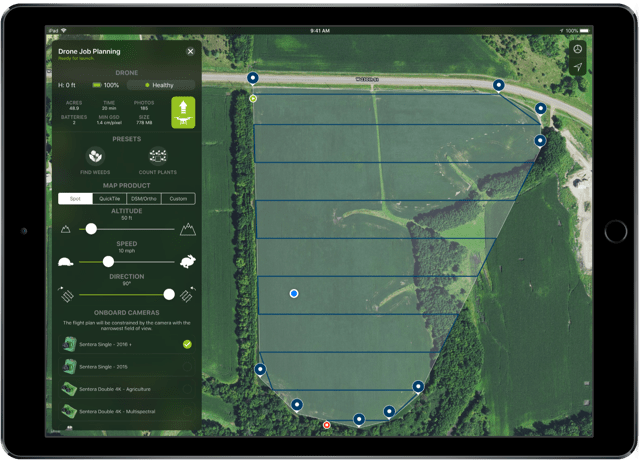Field sensor and AI technology startup Sentera has closed a $14 million Series A round led by Chicago-based agrifood-focused fund S2G Ventures with participation from New York-based Continental Grain Company, and Washington DC-based Middleland Capital.
Founded in 2014, the Minneapolis-based company supplies integrated remote sensing, analytics, and IoT solutions to agronomists, crop consultants, and farmers through a subscription-based service. Designed to rapidly detect nutrition, disease, and plant status issues, the company describes its technology as making it easier for users to integrate field data with a variety of digital ag platforms.
“Obviously everybody likes their funders, but we are particularly happy to have this group behind us,” Sentera CEO Eric Taipale told AgFunderNews. “It’s a very strong syndicate from an agtech perspective. All three of them have adjacent companies, have relevant agtech experience, and have enterprise ag experience, as well as a really good understanding of the problem that we are trying to solve.”
Based on his funding experience, not every VC has an appreciation for the technological sophistication of American agriculture. “We were fortunate to not spend a lot of time with investors who don’t understand the space,” he says. And while some companies find that being located outside of Silicon Valley or other startup hotspots is a disadvantage, the Midwest is teeming with Sentera’s target clientele as well as people who understand the deep nuances and intersections of agricultural production.
The company will use the funds to bolster its distribution channels, focusing on its existing partnerships with John Deere, Climate Corp, and about six other digital platforms that are using its data through application programming interfaces (APIs). Until now, the company has lacked the resources to provide its preferred level of support to its 900 retailer locations throughout North America.
On the tech side, the funding will be used to facilitate what Taipale describes as an enormous amount of new capability including real-time analytics. The company intends to add new features like disease detection into the platform over the next 12 months.
The Series A, which took over a year to close, provides Sentera with an estimated two years of runway, but the company has been pleased with its growth progress, more than doubling the business since its launch. If the growth continues along this trajectory, Taipale has good reason to suspect that they won’t go back for another round and that it will look at other potential opportunities.
Customers and Marketing
Sentera’s primary customer group includes crop advisors an agronomist, or any individual that a grower has engaged to provide insider guidance around seed, fertilizer, and chemicals.
“We give someone who has been scouting crops for 30 years the ability to access 160 sample points and figure out which areas need to be scouted while sitting in the truck instead of having to walk through eight-foot tall corn to figure it out from the ground,” explains Taipale. “WE are not a replacement for crop advisors, we are a fantastic productivity tool.”
Private product insurers have also shown an interest in the startup’s technology, seeing a direct use for the data in creating efficiency and accuracy in the adjustment process, while the lending industry has seen its viability for conducting risk assessments. And while it is primarily used for the classic commodity crops – corn, soybeans, wheat, and cotton – high-value specialty crop growers are particularly keen to identify problems before the solution becomes prohibitively expensive or before crop loss occurs.
The company has primarily sought out customers through its distribution channel and its partnerships with major corporations like John Deere and Climate Corp that already have a digital strategy and clear focus on establishing a connection between advisors, customers, and growers. Although there are many other agtech startups focusing on sensors and analytics, Sentera sees itself as a unique player in the space.
Competitive Landscape
“There really isn’t anybody that is developing the mix of sensors and analytics and who has the breadth of API partners that we have,” Taipale says. “Also, anybody can use our data product and integrate it into an existing workflow. We are not trying to build a silo or fence off data.”
“We don’t make our users assemble a product out of components from different providers. We are unique in that we develop really all throughout the production chain and then we develop mobile cloud software that handles the dissemination of the finished product into a very easy-to-use-off-shelf product.
Although a plethora of sensor and analytics companies means that there is high demand for this service in the agriculture world, it also means that the competition is much stiffer. Cutting through the noise and combating the natural skepticism of potential clients amidst so many options has been a challenge for the company.
“We realize everyone in the ag industry is inundated with technology products that claim to provide major improvements and if it was all true we would be yielding 800 bushels per acre of corn. The biggest hurdle around education and adoption is to get customers to take a fair look at what we are doing and to assess whether or not it saves them time in a way that justifies the cost of deploying the technology. The secret is to not make promises that you aren’t certain you can deliver.”
What’s the best way to break through the reasonable skepticism associated with new technology? Gaining trust by word of mouth with people out in the field.
“It cannot be matched with any other campaign, including social media. It has to be established organically.”




